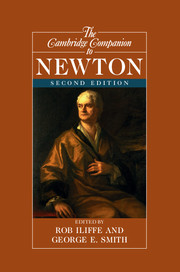(iv)(iv) Studies of the Principia and related topics
Ball, W. W. Rouse, An Essay on Newton’s Principia (London and New York: Macmillan and Co., 1893).
Bertoloni Meli, Domenico, “The Relativization of Centrifugal Force,” Isis 81 (1990), 23–43.
Brackenridge, J. Bruce, “The Critical Role of Curvature in Newton's Developing Dynamics,” in Harman, and Shapiro, (eds.), The Investigation of Difficult Things, listed in Section (ii) above, pp. 231–60.
Brackenridge, J. Bruce, The Key to Newton’s Dynamics: The Kepler Problem and the Principia, with English translations from the Latin by Mary Ann Rossi (Berkeley, CA: University of California Press, 1995).
Chandrasekhar, S., Newton’s Principia for the Common Reader (Oxford: Clarendon Press, 1995).
Cohen, I. B., “Hypotheses in Newton's Philosophy,” Physis 8 (1966), 163–84.
Cohen, I. B., Introduction to Newton’s “Principia” (Cambridge, MA: Harvard University Press; Cambridge: Cambridge University Press, 1971).
De Gandt, François, Force and Geometry in Newton’s Principia, trans. Curtis Wilson (Princeton, NJ: Princeton University Press,1995).
Densmore, Dana, Newton’s Principia: The Central Argument, with translations and illustrations by William Donahue (Santa Fe, NM: Green Lion Press, 1995).
DiSalle, Robert, “Space–Time Theory as Physical Geometry,” Erkenntnis 42 (1995), 317–37.
DiSalle, Robert, Understanding Space–Time: The Philosophical Development of Physics from Newton to Einstein (Cambridge: Cambridge University Press, 2006).
Dobson, Geoffrey J., “Newton's Problems with Rigid Body Dynamics in the Light of his Treatment of the Precession of Equinoxes,” Archive for History of Exact Sciences 53 (1998), 125–45.
Ducheyne, Steffen, The Main Business of Natural Philosophy: Isaac Newton’s Natural-Philosophical Methodology (New York: Springer, 2012).
Earman, John, World Enough and Space–Time: Absolute versus Relational Theories of Space and Time (Cambridge, MA: MIT Press, 1989).
Earman, John and Friedman, Michael, “The Meaning and Status of Newton's Law of Inertia and the Nature of Gravitational Forces,” Philosophy of Science 40 (1973), 329–59.
Ehrlichson, Herman, “The Visualization of Quadratures in the Mystery of Corollary 3 to Proposition 41 of Newton's Principia,” Historia Mathematica 21 (1994), 145–51.
Guicciardini, Niccolò, Reading the Principia: The Debate on Newton’s Mathematical Methods for Natural Philosophy from 1687 to 1736 (Cambridge: Cambridge University Press, 1999).
Harper, William L., “Isaac Newton on Empirical Success and Scientific Method,” in Earman, John and Norton, John D. (eds.), The Cosmos of Science: Essays of Exploration (Pittsburgh, PA: University of Pittsburgh Press, 1997), pp. 55–86.
Harper, William L., Isaac Newton’s Scientific Method: Turning Data into Evidence about Gravity and Cosmology (Oxford: Oxford University Press, 2011).
Herivel, John, The Background to Newton’s Principia: A Study of Newton’s Dynamical Researches in the Years 1664-84 (Oxford: Clarendon Press, 1965).
Janiak, Andrew, Newton as Philosopher (Cambridge: Cambridge University Press, 2008).
Kollerstrom, Nicholas, Newton’s Forgotten Lunar Theory: His Contribution to the Quest for Longitude (Santa Fe, NM: Green Lion Press, 2000).
Lakatos, Imre, “Newton's Effect on Scientific Standards,” in The Methodology of Scientific Research Programmes, Philosophical Papers, vol. 1 (Cambridge: Cambridge University Press, 1978), pp. 193–222.
Maclaurin, Colin, An Account of Sir Isaac Newton’s Philosophical Discoveries (London, 1748).
Nauenberg, Michael, “Newton's Early Computational Method for Dynamics,” Archive for History of Exact Sciences 46 (1994), 221–52.
Nauenberg, Michael, “Newton's Portsmouth Perturbation Method and its Application to Lunar Motion,” in Dalitz, and Nauenberg, (eds.), The Foundations of Newtonian Scholarship, listed in Section (ii) above, pp. 167–94.
Nauenberg, Michael, “Kepler's area law in the Principia: filling in some details in Newton's proof of Proposition I,” Historia Mathematica, 30 (2003), 441–56.
Pourciau, Bruce, “Newton's Argument for Proposition 1 of the Principia,” Archive for History of Exact Sciences 57 (2003), 267–311.
Pourciau, Bruce, “Newton's Interpretation of Newton's Second Law,” Archive for History of Exact Sciences 60 (2006), 157–207.
Rigaud, Stephen Peter, Historical Essay on the First Publication of Sir Isaac Newton’s Principia (Oxford: Oxford University Press, 1838).
Rynasiewicz, Robert, “By Their Properties, Causes and Effects: Newton's Scholium on Time, Space, Place and Motion,” Studies in History and Philosophy of Science 26 (1995), 133–53; 295–321.
Smith, George E., “The Newtonian Style in Book II of the Principia,” in Buchwald, and Cohen, (eds.), Isaac Newton’s Natural Philosophy, listed in Section (ii) above, pp. 249–313.
Smith, George E., “Was Wrong Newton Bad Newton?” in Buchwald, Jed Z. and Allan, Franklin (eds.), Wrong for the Right Reasons (Dordrecht: Springer, 2005).
Smith, George E., “From the Phenomenon of the Ellipse to an Inverse-Square Force: Why Not?” in Malament, David (ed.), Reading Natural Philosophy: Essays in the History and Philosophy of Science and Mathematics to Honor Howard Stein on his 70th Birthday (La Salle, IL: Open Court, 2002).
Smith, George E., “How Newton's Principia Changed Physics,” in Janiak, and Schliesser, (eds.), Interpreting Newton, listed in Section (ii) above, pp. 360–395.
Smith, George E., “Closing the Loop: Testing Newtonian Gravity, Then and Now,” in Biener, and Schliesser, (eds.), Newton and Empiricism, listed in Section (ii) above, pp. 262–351.
Stein, Howard, “Newtonian Space–Time,” Texas Quarterly 10 (1967), 174–200.
Taton, René and Wilson, Curtis (eds.), Planetary Astronomy from the Renaissance to the Rise of Astrophysics, Tycho Brahe to Newton, vol. 2, part A of The General History of Astronomy (Cambridge: Cambridge University Press, 1989).
Weinstock, Robert, “Inverse-Square Orbits in Newton's Principia and Twentieth-Century Commentary Thereon,” Archive for History of Exact Sciences 55 (2000), 137–62.
Whiteside, D. T., “The Mathematical Principles Underlying Newton's Principia,” Journal for the History of Astronomy 1 (1970), 116–38.
Whiteside, D. T., “The Prehistory of the Principia from 1664–1686,” Notes and Records of The Royal Society 45 (1991), 11–61.
Whiteside, D. T., (ed.), The Mathematical Papers of Isaac Newton, vol. 6, listed in Section (ii) above.
Wilson, Curtis, Astronomy from Kepler to Newton: Historical Studies (London: Variorum Reprints, 1989).



